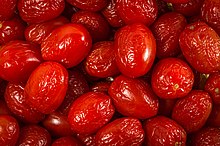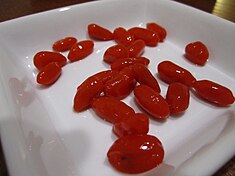code: 2000
What are Goji Berries? This Unique Red Fruit, Explained
Goji berries are tiny red fruits packed with antioxidants and powerful medicinal properties. They’re not only great for adding a pop of color to your plate but also delicious and full of flavor.
These berries are often sold powdered or dried. Plus, they’re added to many supplements and juice blends.
This article takes a close look at the nutrition, benefits, and side effects of goji berries.
An overview of goji berries
Also called wolfberries, goji berries (Lycium barbarum) are native to Asia.
Known for their sweet, slightly sour flavor and vibrant red hue, they’ve been used in traditional medicine for thousands of years. In fact, they’re said to slow signs of aging, maintain eye health, and strengthen your liver, kidneys, and lungs.
Thanks to their growing popularity, goji berries are also frequently featured in supplements and superfood blends alongside other fruits, herbs, and extracts.
Additionally, these berries are often found in dried or powdered forms and added to a variety of recipes.
Potential health benefits
Goji berries have been linked to several potential health benefits.
Highly nutritious
They’re a great source of nutrients, including vitamins and minerals. Just 5 tablespoons (28 grams) of dried goji berries pack
- Calories: 98
- Protein: 4 grams
- Fat: 0.1 grams
- Carbs: 21.6 grams
- Fiber: 3.6 grams
- Sugar: 21.8 grams
- Iron: 11% of the Daily Value (DV)
- Vitamin A: 501% of the DV
- Vitamin C: 15% of the DV
As you can see, even a small serving of this fruit is loaded with fiber, iron, and vitamins A and C
Iron is an essential mineral involved in oxygen transport and the production of healthy red blood cells. Meanwhile, both vitamins A and C play central roles in immune function and act as antioxidants in your body
Antioxidants are compounds that help neutralize harmful molecules called free radicals, preventing cell damage
In fact, one test-tube study found that treating cells with goji berry extract significantly increased antioxidant levels and reduced several markers of oxidative stress
Research suggests that upping your intake of antioxidants reduces inflammation and protects against chronic conditions like cancer, heart disease, and diabetes
Goji, goji berry, or wolfberry (Chinese: 枸杞; pinyin: gǒuqǐ), is the fruit of either Lycium barbarum or Lycium chinense, two closely related species of boxthorn in the nightshade family, Solanaceae. L. barbarum and L. chinense fruits are similar but can be distinguished by differences in taste and sugar content.
Both species are native to Asia, and have been long used in traditional Asian cuisine.
The fruit has also been an ingredient in traditional Chinese, Korean, and Japanese medicine, since at least the 3rd century AD. The plant parts are called by the Latin names lycii fructus (fruit), herba lycii (leaves), etc., in modern official pharmacopeias.
Since about 2000, goji berry and derived products became common in developed countries as health foods or alternative medicine remedies, extending from exaggerated and unproven claims about their health benefits

Etymology and naming
The genus name Lycium was assigned by Linnaeus in 1753. The Latin name lycium is derived from the Greek word λυκιον (lykion), used by Pliny the Elder (23–79) and Pedanius Dioscorides (ca. 40–90) for a plant known as dyer’s buckthorn, which was probably a Rhamnus species. The Greek word refers to the ancient region of Lycia (Λυκία) in Anatolia, where that plant grew.
The common English name, “wolfberry”,has unknown origin. It may have arisen from the mistaken assumption that the Latin name Lycium was derived from Greek λύκος (lycos) meaning “wolf”.
In the English-speaking world, the name “goji berry” has been used since around 2000.The word “goji” is an approximation of the pronunciation of gǒuqǐ (pinyin for 枸杞), the name for the berry producing plant L. chinense in several Chinese dialects.
In technical botanical nomenclature, L. barbarum is called matrimony vine while L. chinense is Chinese desert-thorn.
Uses
Traditional Asian cuisine

Young wolfberry shoots and leaves are harvested commercially as a leaf vegetable. The berries are used in dishes as either a garnish or a source of sweetness.
Food
Fresh goji berries (The wrinkling is due to postharvest dehydration.)
Dried goji berries
Oil extracted from the seeds of Lycium barbarum.
Since the early 21st century, the dried fruit, occasionally compared to raisins, has been marketed as a health food, with unsupported health claims about its benefits.In the wake of those claims, dried and fresh goji berries were included in many snack foods and food supplements, such as granola bars. There are products of whole and ground wolfberry seeds and seed oil.
Marketing controversies
Among the extreme claims used to market the product, often referred to as a “superfruit”, is the unsupported story that a Chinese man named Li Qing Yuen, who was said to have consumed wolfberries daily, lived to the age of 256 years (1677–1933). This claim apparently originated in a 2003 booklet by Earl Mindell, who claimed also that goji had anti-cancer properties.The booklet contained false and unverified claims.
Such exaggerated claims about the health benefits of goji berry and derived products triggered strong reactions, including from government regulatory agencies. In 2006, the U.S. Food and Drug Administration (FDA) placed two goji juice distributors on notice with warning letters about unproven therapeutic benefits. These statements were in violation of the United States Food, Drug and Cosmetic Act because they “establish[ed] the product as a drug intended for use in the cure, mitigation, treatment, or prevention of disease” when wolfberries or juice have had no such scientific evaluation. Additionally stated by the FDA, the goji juice was “not generally recognized as safe and effective for the referenced conditions” and therefore must be treated as a “new drug” under Section of the Act.[citation needed][dubious – discuss] New drugs may not be legally marketed in the United States without prior approval of the FDA.
In January 2007, marketing statements for a goji juice product were the subject of an investigative report by consumer advocacy program Marketplace produced by the Canadian television network, CBC. In the interview, Earl Mindell (then working for direct-marketing company FreeLife International, Inc.) falsely claimed the Memorial Sloan-Kettering Cancer Center in New York had completed clinical studies showing that use of wolfberry juice would prevent 75% of human breast cancer cases.

On 29 May 2009, a class action lawsuit was filed against FreeLife in the United States District Court of Arizona. This lawsuit alleged false claims, misrepresentations, false and deceptive advertising and other issues regarding FreeLife’s Himalayan Goji Juice, GoChi, and TaiSlim products. This lawsuit sought remedies for consumers who had purchased the products over years.A settlement agreement was reached on 28 April 2010, where FreeLife took steps to ensure that its goji products were not marketed as “unheated” or “raw”, and made a contribution to an educational organization.
As with many other novel “health” foods and supplements, the lack of clinical evidence and poor quality control in the manufacture of consumer products prevent goji from being clinically recommended or applied.
Scientific research
Because of the numerous effects claimed by traditional medicine, there has been considerable basic research to investigate possible medicinal uses of substances contained in the fruit. The composition of the fruits, seeds, roots, and other parts have been analyzed in detail, and extracts are under study in vitro and in vivo. However, no clinical effectiveness of such extracts has been confirmed as of 2018.
Safety
Interaction with drugs
In vitro testing suggests that unidentified wolfberry phytochemicals in goji tea may inhibit metabolism of other medications, such as those processed by the cytochrome P450 liver enzymes. Such drugs include warfarin, or drugs for diabetes or hypertension.
Pesticide and fungicide residues
Organochlorine pesticides are conventionally used in commercial wolfberry cultivation to mitigate infestation by insects. China’s Green Food Standard, administered by the Chinese Ministry of Agriculture’s China Green Food Development Center, does permit some amount of pesticide and herbicide use. Agriculture in the Tibetan plateau (where many “Himalayan” or “Tibetan”-branded berries supposedly originate) conventionally uses fertilizers and pesticides, making organic claims for berries originating here dubious.
Since the early 21st century, high levels of insecticide residues (including fenvalerate, cypermethrin, and acetamiprid) and fungicide residues (such as triadimenol and isoprothiolane), have been detected by the United States Food and Drug Administration in some imported wolfberries and wolfberry products of Chinese origin, leading to the seizure of these products.

